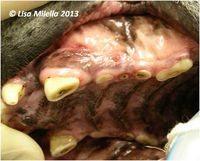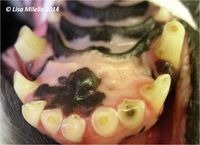Difference between revisions of "Tooth Abrasion and Attrition"
m (Text replace - "Category:LisaM reviewed]]" to "Category:Lisa Milella reviewed]]") |
m (Text replace - "[[Enamel Organ#" to "[[Tooth - Anatomy & Physiology#") |
||
| Line 11: | Line 11: | ||
These conditions often result from excessive abnormal behaviour. | These conditions often result from excessive abnormal behaviour. | ||
| − | Excessive wear can often result in exposure of the [[ | + | Excessive wear can often result in exposure of the [[Tooth - Anatomy & Physiology#Pulp|pulp cavity]]. If the wear is gradual, the pulp may respond by laying down more [[Tooth - Anatomy & Physiology#Dentin|dentine]] – reparative dentine (also known as tertiary dentine). |
==Prevention== | ==Prevention== | ||
Revision as of 13:19, 2 November 2014
Introduction
Tooth abrasion and attrition is wear on tooth surfaces that are in contact with one another or an abrasive surface. This usually results from tooth on tooth contact in certain malocclusions and chewing on fibrous chew toys and balls eg. tennis balls.
Signalment
Occasionally dogs with chronic skin allergies will have abrasion on their incisors from constantly chewing fur/hair.
Aetiology
These conditions often result from excessive abnormal behaviour.
Excessive wear can often result in exposure of the pulp cavity. If the wear is gradual, the pulp may respond by laying down more dentine – reparative dentine (also known as tertiary dentine).
Prevention
Dogs should be prevented from engaging in activities such as cage biting, excessive play with textured balls and chewing stones.

